window FIAT TALENTO 2017 Owner handbook (in English)
[x] Cancel search | Manufacturer: FIAT, Model Year: 2017, Model line: TALENTO, Model: FIAT TALENTO 2017Pages: 228, PDF Size: 4.47 MB
Page 138 of 228
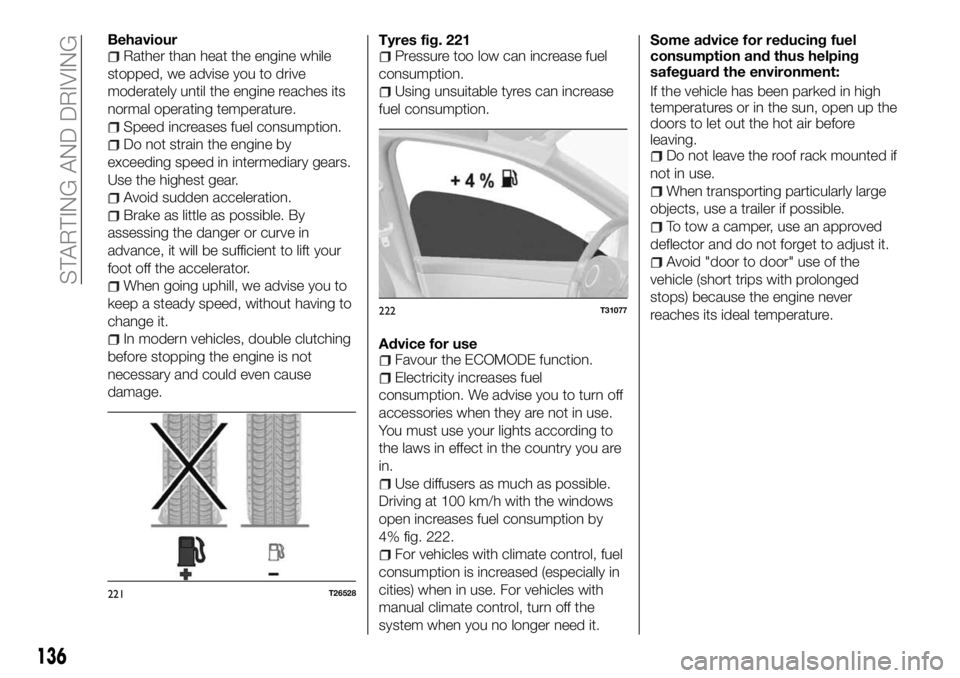
BehaviourRather than heat the engine while
stopped, we advise you to drive
moderately until the engine reaches its
normal operating temperature.
Speed increases fuel consumption.
Do not strain the engine by
exceeding speed in intermediary gears.
Use the highest gear.
Avoid sudden acceleration.
Brake as little as possible. By
assessing the danger or curve in
advance, it will be sufficient to lift your
foot off the accelerator.
When going uphill, we advise you to
keep a steady speed, without having to
change it.
In modern vehicles, double clutching
before stopping the engine is not
necessary and could even cause
damage.Tyres fig. 221
Pressure too low can increase fuel
consumption.
Using unsuitable tyres can increase
fuel consumption.
Advice for use
Favour the ECOMODE function.
Electricity increases fuel
consumption. We advise you to turn off
accessories when they are not in use.
You must use your lights according to
the laws in effect in the country you are
in.
Use diffusers as much as possible.
Driving at 100 km/h with the windows
open increases fuel consumption by
4% fig. 222.
For vehicles with climate control, fuel
consumption is increased (especially in
cities) when in use. For vehicles with
manual climate control, turn off the
system when you no longer need it.Some advice for reducing fuel
consumption and thus helping
safeguard the environment:
If the vehicle has been parked in high
temperatures or in the sun, open up the
doors to let out the hot air before
leaving.
Do not leave the roof rack mounted if
not in use.
When transporting particularly large
objects, use a trailer if possible.
To tow a camper, use an approved
deflector and do not forget to adjust it.
Avoid "door to door" use of the
vehicle (short trips with prolonged
stops) because the engine never
reaches its ideal temperature.
221T26528
222T31077
136
STARTING AND DRIVING
Page 147 of 228
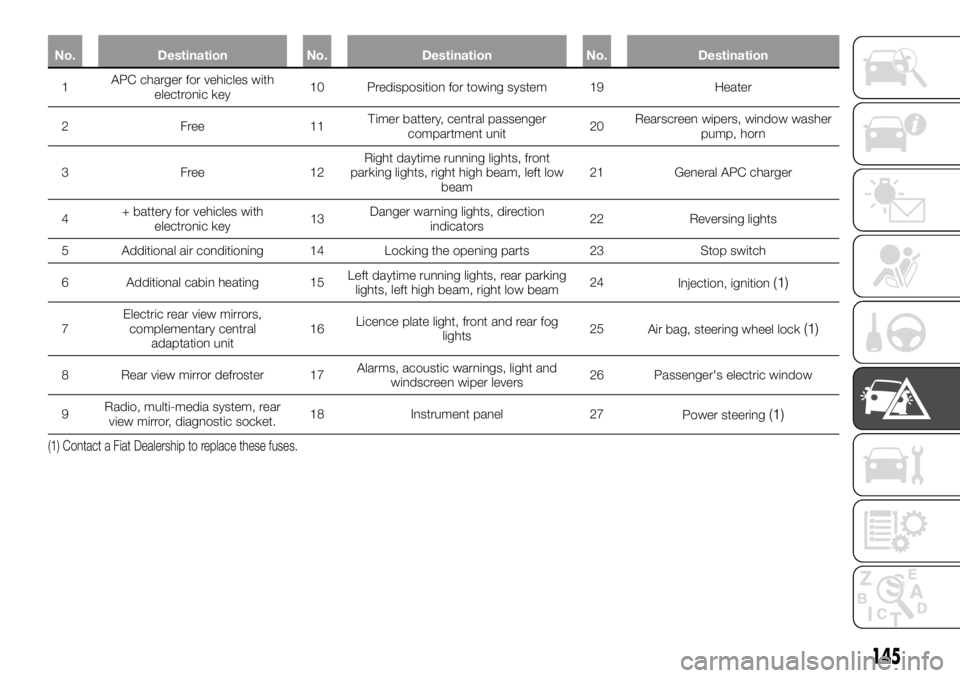
No. Destination No. Destination No. Destination
1APCcharger for vehicles with
electronic key10 Predisposition for towing system 19 Heater
2Free11Timer battery, central passenger
compartment unit20Rearscreen wipers, window washer
pump, horn
3Free12Right daytime running lights, front
parking lights, right high beam, left low
beam21 General APC charger
4+ battery for vehicles with
electronic key13Danger warning lights, direction
indicators22 Reversing lights
5 Additional air conditioning 14 Locking the opening parts 23 Stop switch
6 Additional cabin heating 15Left daytime running lights, rear parking
lights, left high beam, right low beam24
Injection, ignition
(1)
7Electric rear view mirrors,
complementary central
adaptation unit16Licence plate light, front and rear fog
lights25
Air bag, steering wheel lock(1)
8 Rear view mirror defroster 17Alarms, acoustic warnings, light and
windscreen wiper levers26 Passenger's electric window
9Radio, multi-media system, rear
view mirror, diagnostic socket.18 Instrument panel 27
Power steering
(1)
(1) Contact a Fiat Dealership to replace these fuses.
145
Page 148 of 228
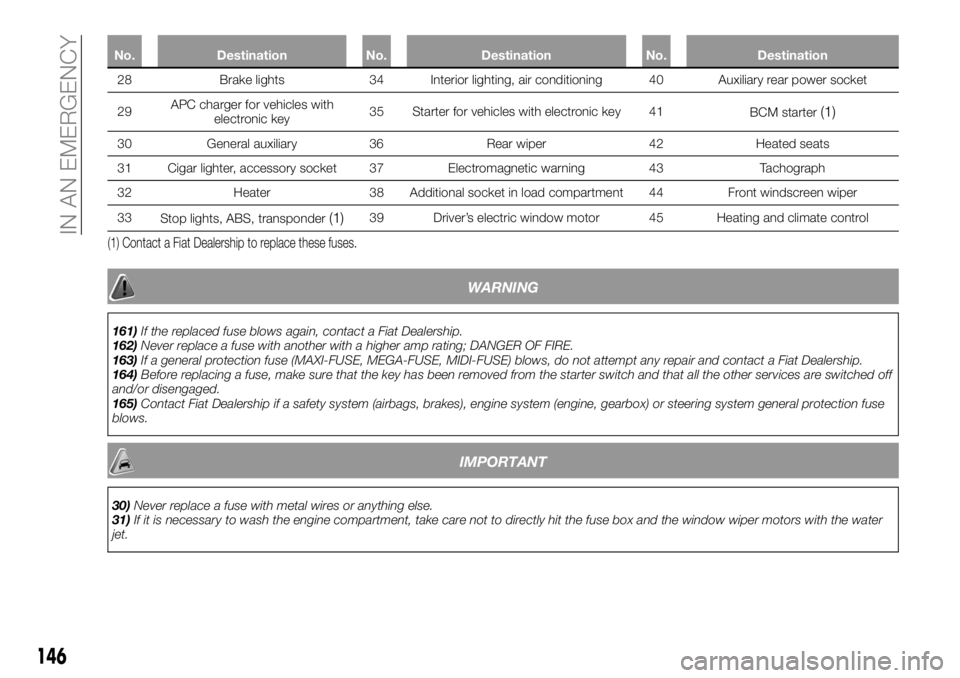
No. Destination No. Destination No. Destination
28 Brake lights 34 Interior lighting, air conditioning 40 Auxiliary rear power socket
29APCcharger for vehicles with
electronic key35 Starter for vehicles with electronic key 41
BCM starter
(1)
30 General auxiliary 36 Rear wiper 42 Heated seats
31 Cigar lighter, accessory socket 37 Electromagnetic warning 43 Tachograph
32 Heater 38 Additional socket in load compartment 44 Front windscreen wiper
33
Stop lights, ABS, transponder
(1)39 Driver’s electric window motor 45 Heating and climate control
(1) Contact a Fiat Dealership to replace these fuses.
WARNING
161)If the replaced fuse blows again, contact a Fiat Dealership.
162)Never replace a fuse with another with a higher amp rating; DANGER OF FIRE.
163)If a general protection fuse (MAXI-FUSE, MEGA-FUSE, MIDI-FUSE) blows, do not attempt any repair and contact a Fiat Dealership.
164)Before replacing a fuse, make sure that the key has been removed from the starter switch and that all the other services are switched off
and/or disengaged.
165)Contact Fiat Dealership if a safety system (airbags, brakes), engine system (engine, gearbox) or steering system general protection fuse
blows.
IMPORTANT
30)Never replace a fuse with metal wires or anything else.
31)If it is necessary to wash the engine compartment, take care not to directly hit the fuse box and the window wiper motors with the water
jet.
146
IN AN EMERGENCY
Page 158 of 228
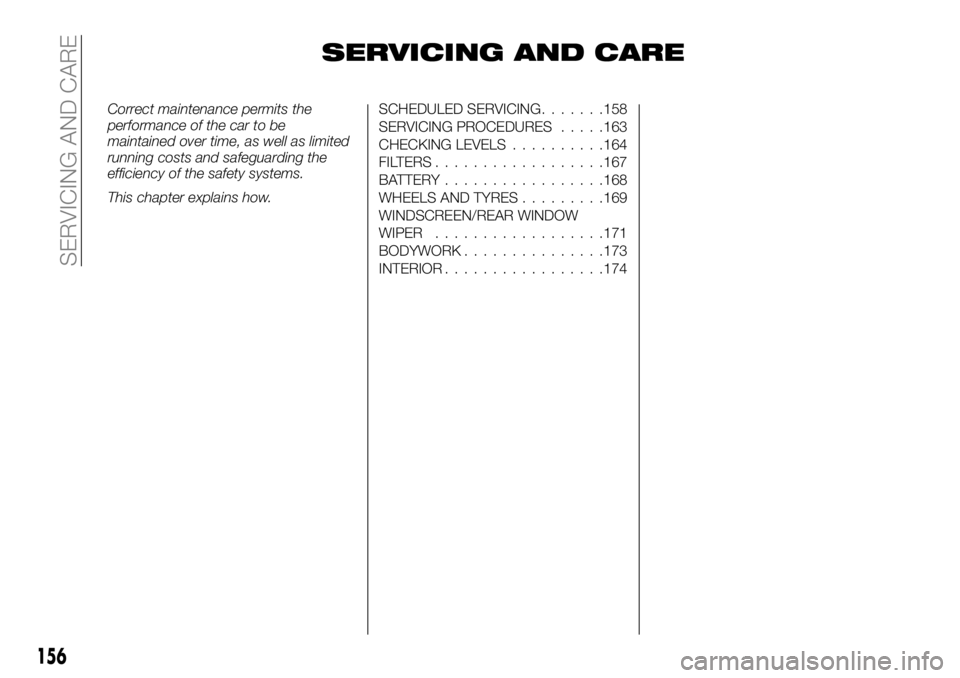
SERVICING AND CARE
Correct maintenance permits the
performance of the car to be
maintained over time, as well as limited
running costs and safeguarding the
efficiency of the safety systems.
This chapter explains how.SCHEDULED SERVICING.......158
SERVICING PROCEDURES.....163
CHECKING LEVELS..........164
FILTERS..................167
BATTERY.................168
WHEELS AND TYRES.........169
WINDSCREEN/REAR WINDOW
WIPER..................171
BODYWORK...............173
INTERIOR.................174
156
SERVICING AND CARE
Page 164 of 228
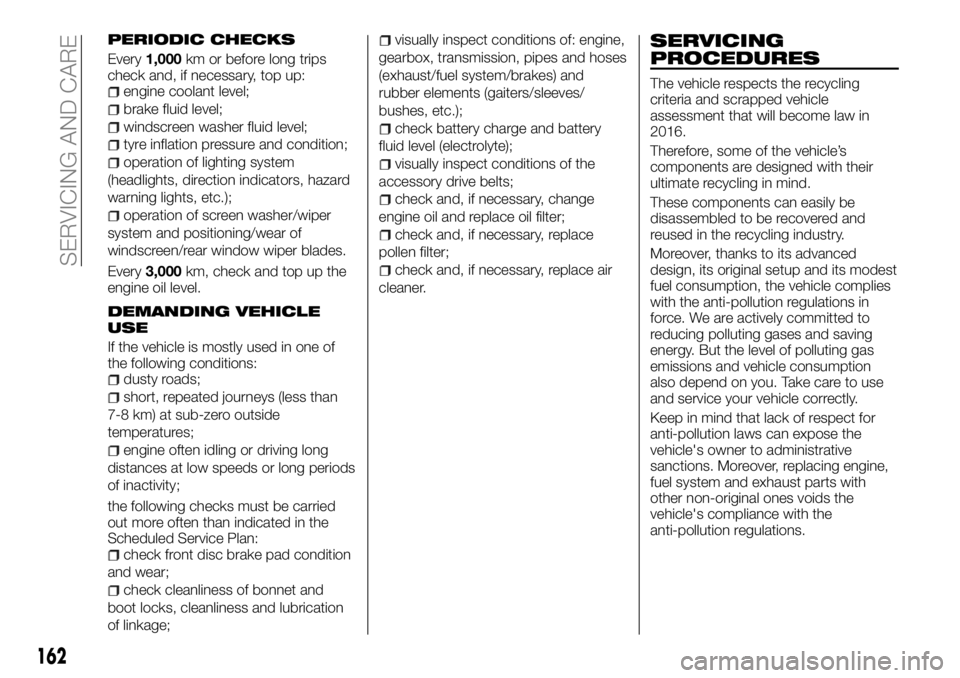
PERIODIC CHECKS
Every1,000km or before long trips
check and, if necessary, top up:
engine coolant level;
brake fluid level;
windscreen washer fluid level;
tyre inflation pressure and condition;
operation of lighting system
(headlights, direction indicators, hazard
warning lights, etc.);
operation of screen washer/wiper
system and positioning/wear of
windscreen/rear window wiper blades.
Every3,000km, check and top up the
engine oil level.
DEMANDING VEHICLE
USE
If the vehicle is mostly used in one of
the following conditions:
dusty roads;
short, repeated journeys (less than
7-8 km) at sub-zero outside
temperatures;
engine often idling or driving long
distances at low speeds or long periods
of inactivity;
the following checks must be carried
out more often than indicated in the
Scheduled Service Plan:
check front disc brake pad condition
and wear;
check cleanliness of bonnet and
boot locks, cleanliness and lubrication
of linkage;
visually inspect conditions of: engine,
gearbox, transmission, pipes and hoses
(exhaust/fuel system/brakes) and
rubber elements (gaiters/sleeves/
bushes, etc.);
check battery charge and battery
fluid level (electrolyte);
visually inspect conditions of the
accessory drive belts;
check and, if necessary, change
engine oil and replace oil filter;
check and, if necessary, replace
pollen filter;
check and, if necessary, replace air
cleaner.
SERVICING
PROCEDURES
The vehicle respects the recycling
criteria and scrapped vehicle
assessment that will become law in
2016.
Therefore, some of the vehicle’s
components are designed with their
ultimate recycling in mind.
These components can easily be
disassembled to be recovered and
reused in the recycling industry.
Moreover, thanks to its advanced
design, its original setup and its modest
fuel consumption, the vehicle complies
with the anti-pollution regulations in
force. We are actively committed to
reducing polluting gases and saving
energy. But the level of polluting gas
emissions and vehicle consumption
also depend on you. Take care to use
and service your vehicle correctly.
Keep in mind that lack of respect for
anti-pollution laws can expose the
vehicle's owner to administrative
sanctions. Moreover, replacing engine,
fuel system and exhaust parts with
other non-original ones voids the
vehicle's compliance with the
anti-pollution regulations.
162
SERVICING AND CARE
Page 167 of 228
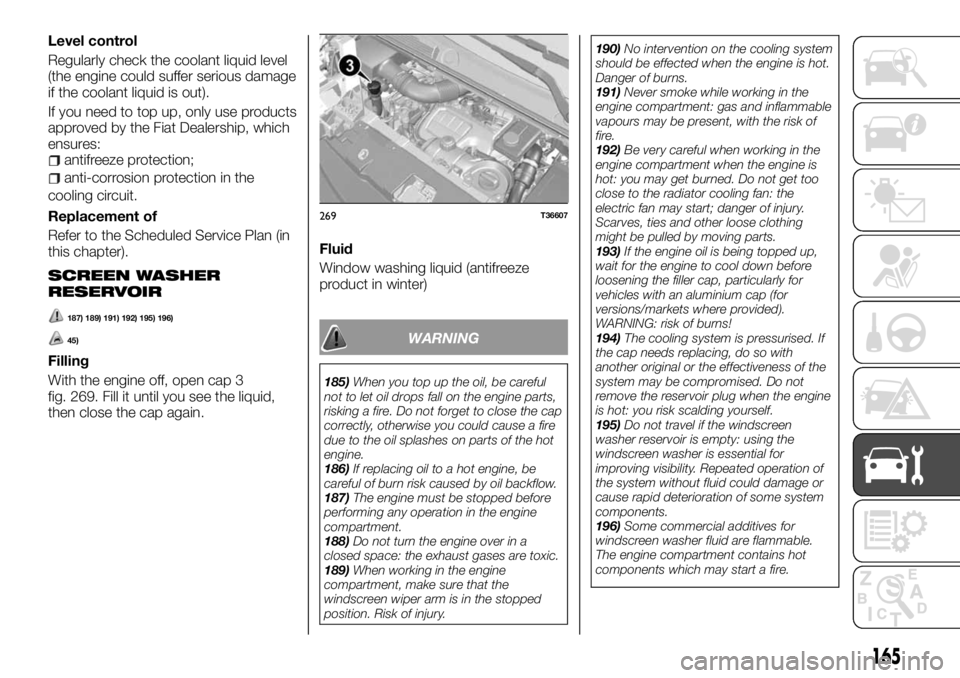
Level control
Regularly check the coolant liquid level
(the engine could suffer serious damage
if the coolant liquid is out).
If you need to top up, only use products
approved by the Fiat Dealership, which
ensures:
antifreeze protection;
anti-corrosion protection in the
cooling circuit.
Replacement of
Refer to the Scheduled Service Plan (in
this chapter).
SCREEN WASHER
RESERVOIR
187) 189) 191) 192) 195) 196)
45)
Filling
With the engine off, open cap 3
fig. 269. Fill it until you see the liquid,
then close the cap again.Fluid
Window washing liquid (antifreeze
product in winter)
WARNING
185)When you top up the oil, be careful
not to let oil drops fall on the engine parts,
risking a fire. Do not forget to close the cap
correctly, otherwise you could cause a fire
due to the oil splashes on parts of the hot
engine.
186)If replacing oil to a hot engine, be
careful of burn risk caused by oil backflow.
187)The engine must be stopped before
performing any operation in the engine
compartment.
188)Do not turn the engine over in a
closed space: the exhaust gases are toxic.
189)When working in the engine
compartment, make sure that the
windscreen wiper arm is in the stopped
position. Risk of injury.190)No intervention on the cooling system
should be effected when the engine is hot.
Danger of burns.
191)Never smoke while working in the
engine compartment: gas and inflammable
vapours may be present, with the risk of
fire.
192)Be very careful when working in the
engine compartment when the engine is
hot: you may get burned. Do not get too
close to the radiator cooling fan: the
electric fan may start; danger of injury.
Scarves, ties and other loose clothing
might be pulled by moving parts.
193)If the engine oil is being topped up,
wait for the engine to cool down before
loosening the filler cap, particularly for
vehicles with an aluminium cap (for
versions/markets where provided).
WARNING: risk of burns!
194)The cooling system is pressurised. If
the cap needs replacing, do so with
another original or the effectiveness of the
system may be compromised. Do not
remove the reservoir plug when the engine
is hot: you risk scalding yourself.
195)Do not travel if the windscreen
washer reservoir is empty: using the
windscreen washer is essential for
improving visibility. Repeated operation of
the system without fluid could damage or
cause rapid deterioration of some system
components.
196)Some commercial additives for
windscreen washer fluid are flammable.
The engine compartment contains hot
components which may start a fire.
269T36607
165
Page 172 of 228
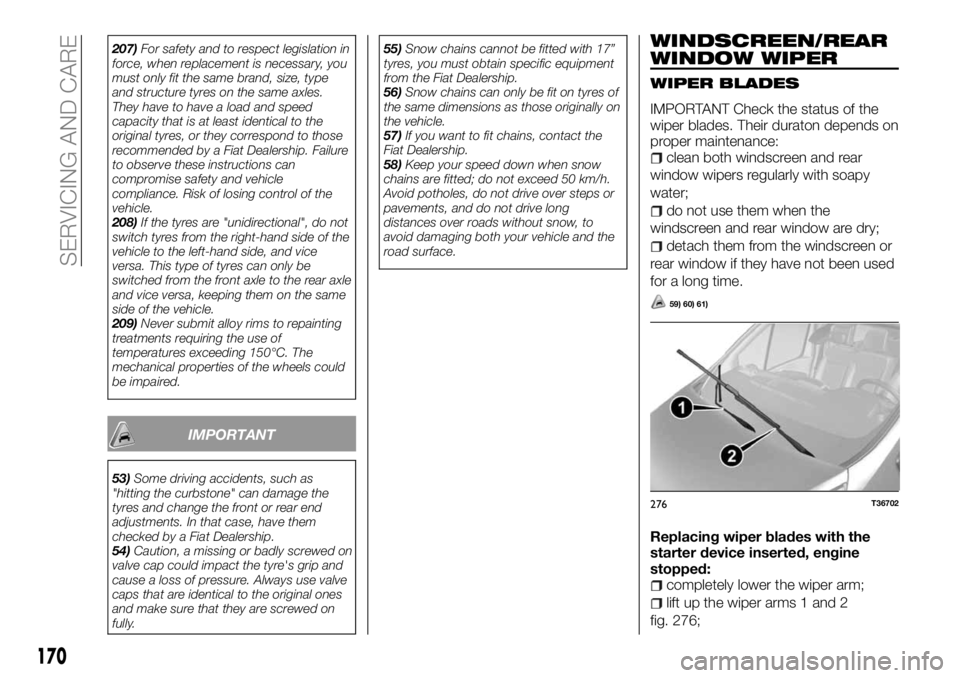
207)For safety and to respect legislation in
force, when replacement is necessary, you
must only fit the same brand, size, type
and structure tyres on the same axles.
They have to have a load and speed
capacity that is at least identical to the
original tyres, or they correspond to those
recommended by a Fiat Dealership. Failure
to observe these instructions can
compromise safety and vehicle
compliance. Risk of losing control of the
vehicle.
208)If the tyres are "unidirectional", do not
switch tyres from the right-hand side of the
vehicle to the left-hand side, and vice
versa. This type of tyres can only be
switched from the front axle to the rear axle
and vice versa, keeping them on the same
side of the vehicle.
209)Never submit alloy rims to repainting
treatments requiring the use of
temperatures exceeding 150°C. The
mechanical properties of the wheels could
be impaired.
IMPORTANT
53)Some driving accidents, such as
"hitting the curbstone" can damage the
tyres and change the front or rear end
adjustments. In that case, have them
checked by a Fiat Dealership.
54)Caution, a missing or badly screwed on
valve cap could impact the tyre's grip and
cause a loss of pressure. Always use valve
caps that are identical to the original ones
and make sure that they are screwed on
fully.55)Snow chains cannot be fitted with 17”
tyres, you must obtain specific equipment
from the Fiat Dealership.
56)Snow chains can only be fit on tyres of
the same dimensions as those originally on
the vehicle.
57)If you want to fit chains, contact the
Fiat Dealership.
58)Keep your speed down when snow
chains are fitted; do not exceed 50 km/h.
Avoid potholes, do not drive over steps or
pavements, and do not drive long
distances over roads without snow, to
avoid damaging both your vehicle and the
road surface.
WINDSCREEN/REAR
WINDOW WIPER
WIPER BLADES
IMPORTANT Check the status of the
wiper blades. Their duraton depends on
proper maintenance:
clean both windscreen and rear
window wipers regularly with soapy
water;
do not use them when the
windscreen and rear window are dry;
detach them from the windscreen or
rear window if they have not been used
for a long time.
59) 60) 61)
Replacing wiper blades with the
starter device inserted, engine
stopped:
completely lower the wiper arm;
lift up the wiper arms 1 and 2
fig. 276;
276T36702
170
SERVICING AND CARE
Page 173 of 228
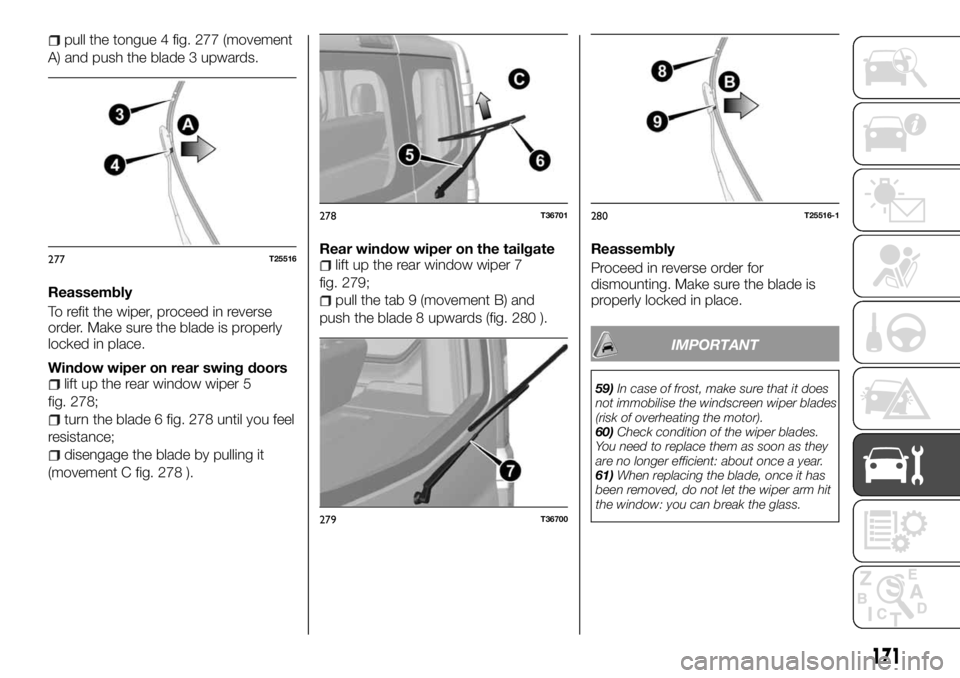
pull the tongue 4 fig. 277 (movement
A) and push the blade 3 upwards.
Reassembly
To refit the wiper, proceed in reverse
order. Make sure the blade is properly
locked in place.
Window wiper on rear swing doors
lift up the rear window wiper 5
fig. 278;
turn the blade 6 fig. 278 until you feel
resistance;
disengage the blade by pulling it
(movement C fig. 278 ).Rear window wiper on the tailgate
lift up the rear window wiper 7
fig. 279;
pull the tab 9 (movement B) and
push the blade 8 upwards (fig. 280 ).Reassembly
Proceed in reverse order for
dismounting. Make sure the blade is
properly locked in place.
IMPORTANT
59)In case of frost, make sure that it does
not immobilise the windscreen wiper blades
(risk of overheating the motor).
60)Check condition of the wiper blades.
You need to replace them as soon as they
are no longer efficient: about once a year.
61)When replacing the blade, once it has
been removed, do not let the wiper arm hit
the window: you can break the glass.
277T25516
278T36701
279T36700
280T25516-1
171
Page 175 of 228
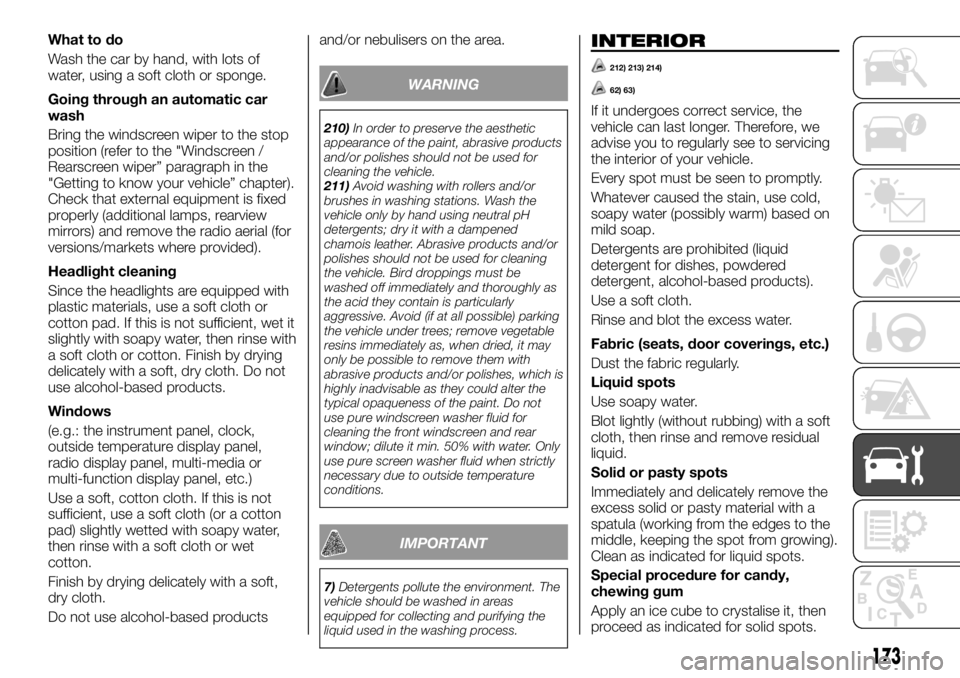
What to do
Wash the car by hand, with lots of
water, using a soft cloth or sponge.
Going through an automatic car
wash
Bring the windscreen wiper to the stop
position (refer to the "Windscreen /
Rearscreen wiper” paragraph in the
"Getting to know your vehicle” chapter).
Check that external equipment is fixed
properly (additional lamps, rearview
mirrors) and remove the radio aerial (for
versions/markets where provided).
Headlight cleaning
Since the headlights are equipped with
plastic materials, use a soft cloth or
cotton pad. If this is not sufficient, wet it
slightly with soapy water, then rinse with
a soft cloth or cotton. Finish by drying
delicately with a soft, dry cloth. Do not
use alcohol-based products.
Windows
(e.g.: the instrument panel, clock,
outside temperature display panel,
radio display panel, multi-media or
multi-function display panel, etc.)
Use a soft, cotton cloth. If this is not
sufficient, use a soft cloth (or a cotton
pad) slightly wetted with soapy water,
then rinse with a soft cloth or wet
cotton.
Finish by drying delicately with a soft,
dry cloth.
Do not use alcohol-based productsand/or nebulisers on the area.
WARNING
210)In order to preserve the aesthetic
appearance of the paint, abrasive products
and/or polishes should not be used for
cleaning the vehicle.
211)Avoid washing with rollers and/or
brushes in washing stations. Wash the
vehicle only by hand using neutral pH
detergents; dry it with a dampened
chamois leather. Abrasive products and/or
polishes should not be used for cleaning
the vehicle. Bird droppings must be
washed off immediately and thoroughly as
the acid they contain is particularly
aggressive. Avoid (if at all possible) parking
the vehicle under trees; remove vegetable
resins immediately as, when dried, it may
only be possible to remove them with
abrasive products and/or polishes, which is
highly inadvisable as they could alter the
typical opaqueness of the paint. Do not
use pure windscreen washer fluid for
cleaning the front windscreen and rear
window; dilute it min. 50% with water. Only
use pure screen washer fluid when strictly
necessary due to outside temperature
conditions.
IMPORTANT
7)Detergents pollute the environment. The
vehicle should be washed in areas
equipped for collecting and purifying the
liquid used in the washing process.
INTERIOR
212) 213) 214)
62) 63)
If it undergoes correct service, the
vehicle can last longer. Therefore, we
advise you to regularly see to servicing
the interior of your vehicle.
Every spot must be seen to promptly.
Whatever caused the stain, use cold,
soapy water (possibly warm) based on
mild soap.
Detergents are prohibited (liquid
detergent for dishes, powdered
detergent, alcohol-based products).
Use a soft cloth.
Rinse and blot the excess water.
Fabric (seats, door coverings, etc.)
Dust the fabric regularly.
Liquid spots
Use soapy water.
Blot lightly (without rubbing) with a soft
cloth, then rinse and remove residual
liquid.
Solid or pasty spots
Immediately and delicately remove the
excess solid or pasty material with a
spatula (working from the edges to the
middle, keeping the spot from growing).
Clean as indicated for liquid spots.
Special procedure for candy,
chewing gum
Apply an ice cube to crystalise it, then
proceed as indicated for solid spots.
173
Page 225 of 228
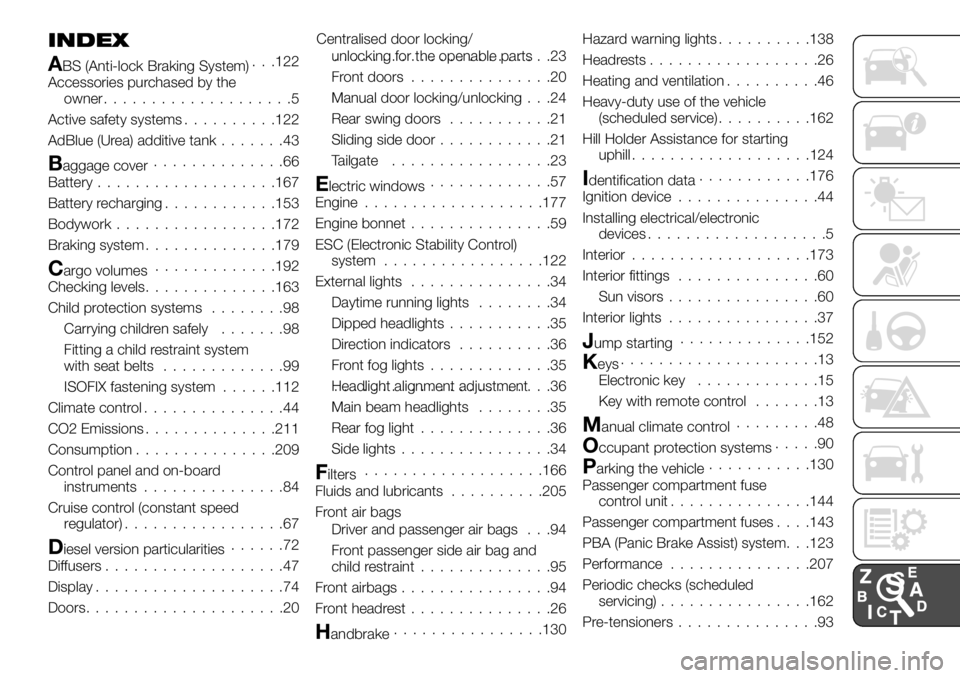
INDEX
ABS (Anti-lock Braking System). . .122
Accessories purchased by the
owner....................5
Active safety systems..........122
AdBlue (Urea) additive tank.......43
Baggage cover..............66
Battery...................167
Battery recharging............153
Bodywork.................172
Braking system..............179
Cargo volumes.............192
Checking levels..............163
Child protection systems........98
Carrying children safely.......98
Fitting a child restraint system
with seat belts.............99
ISOFIX fastening system......112
Climate control...............44
CO2 Emissions..............211
Consumption...............209
Control panel and on-board
instruments...............84
Cruise control (constant speed
regulator).................67
Diesel version particularities......72
Diffusers...................47
Display....................74
Doors.....................20Centralised door locking/
unlocking for the openable parts.......................23
Front doors...............20
Manual door locking/unlocking . . .24
Rear swing doors...........21
Sliding side door............21
Tailgate.................23
Electric windows.............57
Engine...................177
Engine bonnet...............59
ESC (Electronic Stability Control)
system.................122
External lights...............34
Daytime running lights........34
Dipped headlights...........35
Direction indicators..........36
Front fog lights.............35
Headlight alignment adjustment.......................36
Main beam headlights........35
Rear fog light..............36
Side lights................34
Filters...................166
Fluids and lubricants..........205
Front air bags
Driver and passenger air bags . . .94
Front passenger side air bag and
child restraint..............95
Front airbags................94
Front headrest...............26
Handbrake................130Hazard warning lights..........138
Headrests..................26
Heating and ventilation..........46
Heavy-duty use of the vehicle
(scheduled service)..........162
Hill Holder Assistance for starting
uphill...................124
Identification data............176
Ignition device...............44
Installing electrical/electronic
devices...................5
Interior...................173
Interior fittings...............60
Sun visors................60
Interior lights................37
Jump starting..............152
Keys.....................13
Electronic key.............15
Key with remote control.......13
Manual climate control.........48
Occupant protection systems.....90
Parking the vehicle...........130
Passenger compartment fuse
control unit...............144
Passenger compartment fuses. . . .143
PBA (Panic Brake Assist) system. . .123
Performance...............207
Periodic checks (scheduled
servicing)................162
Pre-tensioners...............93